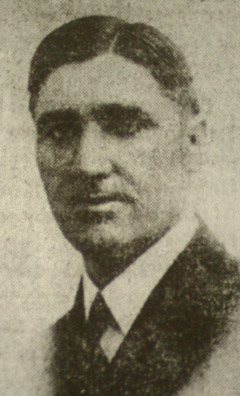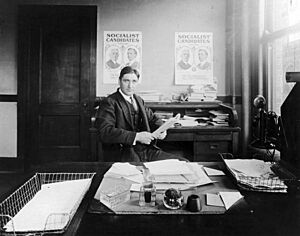Adolph Germer facts for kids
Adolph F. Germer (born January 15, 1881 – died May 26, 1966) was an American socialist leader and union organizer. He is best known for being the National Executive Secretary of the Socialist Party of America from 1916 to 1919. During this time, a new group called the Left Wing Section of the Socialist Party formed within the party. Germer, as a leader of the main "Regular" group, helped remove or reorganize some of these left-wing groups. This led to the left-wing members forming their own new parties, like the Communist Labor Party of America and the Communist Party of America.
Contents
Biography
Early Life and Work
Adolph F. Germer was born on January 15, 1881, in Welan, East Prussia, Germany. His father was a miner. In December 1888, Germer and his family moved to the United States. He went to public school in Braceville, Illinois. He also attended a Lutheran church school and finished his high school studies through correspondence courses. He also took classes at LaSalle Extension University.
Like his father, Germer started working in the mines at a very young age. When he was 11, he worked as a trapper in a coal mine near Staunton, Illinois. He joined the United Mine Workers of America (UMWA) union in 1894.
Germer moved from working in the mines to becoming a union official. In 1906, he was chosen as Secretary of UMWA Local 728. The next year, he became a sub-district vice president of the union. In 1908, he was elected secretary-treasurer of the UMWA sub-district, a job he held until 1912. That same year, he represented the United Mine Workers at the World Miners' Congress in Amsterdam.
Political Career
Germer joined the Social Democratic Party of America in 1900. This party later became the Socialist Party of America (SPA).
In 1912, Germer ran for the Illinois legislature as a candidate for the Socialist Party of Illinois.
In 1913, Germer was elected to the main governing group of the Socialist Party, called the National Executive Committee. At the same time, he worked as an organizer for the UMWA union. In December 1913, Germer was arrested in Walsenburg, Colorado. This was a place where a big mine strike, known as the Colorado Coalfield War, was happening. Germer was held in jail and could not communicate with anyone for almost a week. His papers were also searched. His wife, Mabel Germer, was also briefly arrested. After he was released, Germer continued to help organize workers during the difficult Colorado coal strike.
In 1914, Germer was elected Vice President of the Illinois Mine Workers, which was part of the UMWA. He also ran for United States Senate from Illinois as a Socialist in the election that fall.
From 1916 to 1919, Germer was the National Executive Secretary of the Socialist Party of America. He was elected twice by votes from party members. He won in 1916 because he had strong support from the party's language groups. Many of these groups voted for Germer all at once.
Germer strongly believed in peace and was against war. He followed the party's rules against World War I, which were set at their 1917 Emergency National Convention in St. Louis. Because of this, he was accused of breaking the Espionage Act in Chicago on February 2, 1918. His trial began on December 6, 1918. On January 9, 1919, Germer and four other Socialist Party members were found guilty. The judge sentenced them to 20 years in prison. However, this sentence was later overturned because the judge was found to be biased.
Germer was released on bail while waiting for his appeal. A wealthy socialist named William Bross Lloyd paid his bail.
In 1919, Germer helped guide the National Executive Committee. This group canceled the party's elections that year, saying there was fraud. They also suspended some language groups and reorganized state groups for supposedly breaking the party's rules. Germer organized a meeting of loyal Socialist Party members before the convention opened on August 30, 1919. He also officially started that meeting.
After the difficult 1919 convention, Germer left his job as Executive Secretary of the Socialist Party. His friend Otto Branstetter took his place. Germer continued to work for the Socialist Party as a National Organizer from October 1919 through 1920. In 1920, he left the national party, which was almost out of money. He then worked for the Local New York branch, which was doing better, as an organizer until 1922. Germer was also Assistant Secretary of Local New York, working with his friend Julius Gerber starting in August 1921.
In November 1921, Germer ran as a Socialist candidate for the New York State Assembly.
After the 1921 election, Germer moved to Massachusetts. He became the State Secretary of the Socialist Party of Massachusetts in December. He stayed in that job for about a year.
Return to Union Organizing
After leaving the Socialist Party, Germer got a job in the oil industry in California in 1923. He joined the Oil Field, Gas Well and Refinery Workers Union there. Later, he worked as an organizer for that union.
Germer was active in the 1924 Presidential campaign for Robert M. La Follette.
In 1926, Germer moved back to Chicago. He worked for a large real estate company until the Great Depression started in 1930.
In 1930, Germer was elected a vice president of the reorganized United Mine Workers of America. The next year, he returned to his hometown of Mt. Olive, Illinois. He worked as a miner again until the mine closed due to the economic problems.
In June 1931, Germer became the editor of the Rockford Labor News newspaper. He stayed in that role until the end of 1933.
In November 1935, John L. Lewis appointed Germer as the first field representative for the Congress of Industrial Organizations (CIO). In this role, Germer helped organize workers and lead strikes for auto and rubber workers in the Midwest. Germer was especially important as a key organizer in the 1937 United Auto Workers strike against General Motors.
Germer officially retired from the AFL-CIO union on April 1, 1955. However, he continued to work for the organization on special projects.
Later Life and Legacy
After retiring, Germer moved back to Illinois. He passed away in Rockford, Illinois, in May 1966.
Most of Germer's important papers are kept at the State Historical Society of Wisconsin in Madison. You can find them on microfilm. A smaller collection of his papers, about his work with the World Federation of Trade Unions from 1945 to 1947, is at Cornell University in Ithaca, New York.
An oral history interview with Germer was done in 1959. In this interview, he talked about his experiences as a United Auto Workers organizer. This interview material is at the Reuther Library of Wayne State University in Detroit, Michigan.
Works
- Report of Executive Secretary [to the] Emergency National Convention, St. Louis, April 7, 1917. St. Louis: n.p., 1917.
- Defeated? Organizational leaflet no. 13. Chicago: National Office of the Socialist Party, 1918.
- In the United States Circuit Court of Appeals for the Seventh Circuit. October term, A.D. 1918. Victor L. Berger, Adolph Germer, William F. Kruse, Irwin St. John Tucker and J. Louis Engdahl, plaintiffs in error, vs. United States of America, defendant in error. Error to the District Court of the United States for the Northern District of Illinois, Eastern Division, K.M. Landis, Judge ... Brief for the plaintiffs in error. With Messrs. Berger, Kruse, Tucker, and Engdahl. Chicago: The Court, 1919.



